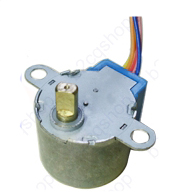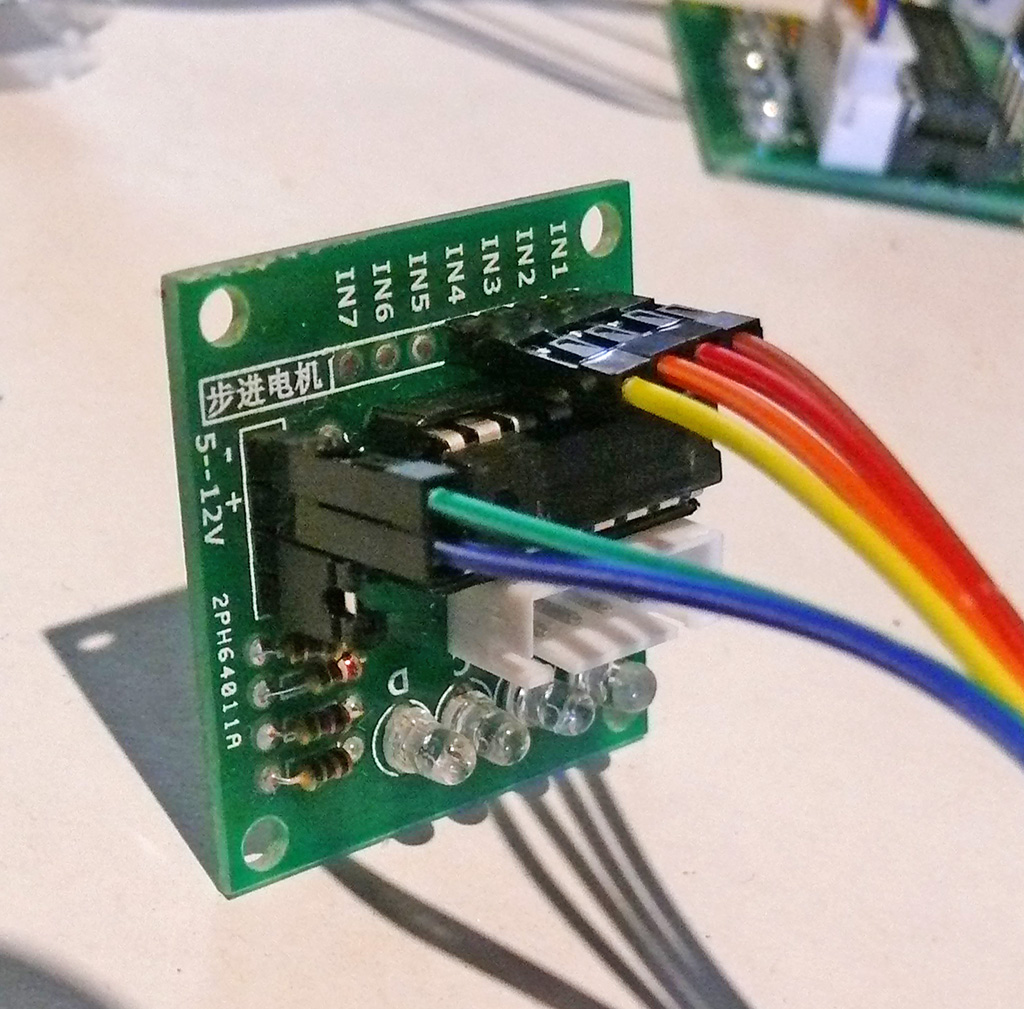SmallSteppers
Small Stepper Motor and Driver Board
See[/SmallSteppers#1turn 1-turn Arduino Sketch HERE:]
NOTE: The connections can be confusing! The code examples below assume you are connecting 4 (or 8) Arduino pins in sequence to pins IN1,IN2,IN3,IN4 on the motor driver board shown. Then in the stepper library statement the correct sequence of motor pins is taken care of. See photos below.
MOTOR DETAILS
This is a 5v 28YBJ-48 Stepper Motor with Gear Reduction, so it has good torque for its size, but relatively slow motion. These motors/drivers are made by the millions for A/C units, fans, duct controls etc. which is why they are so inexpensive.
4 Phase 5 Wire Connection
- Phase : 4
- Current : 160 mA per winding (320 mA in 4-step mode) Measured: 250mA stopped, 200 mA running fast
- Resistance : 31 Ω per coil winding (from Red wire to any coil) (Some 24-28 ohms)
- Voltage : 5V DC
- Step Angle (8-Step sequence: Internal Motor alone): 5.625° (64 steps per revolution)
- Step Angle (4-Step sequence: Internal Motor alone): 11.25° (32 steps per revolution)
- Gear Reduction ratio: 1 / 64 (Not really exact: probably 63.68395.:1 )
- SO: it takes (64*64 = 4096 steps per output shaft revolution.. In 8-step sequence.
- SO: it takes (32*64 = 2048 steps per output shaft revolution.. In 4-step sequence.
- NOTE: Arduino "Stepper Library" runs in 4-step mode
- No-Load Pull-Out Frequency : 800pps
- No-Load Pull-In Frequency : 500pps
- Pull-In Torque : ≥ 78.4mN.m
- Wiring Instruction : A (Blue), B (Pink), C (Yellow), D (Orange), E (Red, Mid-Point)
- Weight : 30g
Wiring Diagrams
See wiring diagram, following...
| Diagram of the driver board |
NOTE: This type of "Bipolar" motor with connected-together center taps CAN be changed to "Unipolar" with the use of a different more complex driver board and modifying the motor as shown in THIS PFD FILE: Media:RewireTheSmallStepperMotor.pdf
CONNECTION NOTES: (Motor Just Vibrates??)
NOTE: If your motor vibrates but does not turn or will only run in one direction, it's wires are probably connected with the wrong sequence.
The Arduino pin connections need to have 4 pins connected to Motor Driver In1, In2, In3, In4 and then the pins entered in the software in the sequence 1-3-2-4 for proper sequencing. Also, The + and - pins near "5-12V" need to be connected:
- - to Arduino Ground,
- + to Arduino +5 (for one motor test only) or (best) to a separate +5V 1A power supply.
Example: Arduino Connections=
Pins 8,9,10,11 will be connected to In1,In2,In3,In4 Color code sequence: Brown-Red-Orange-Yellow Then Green=Ground, Blue=5V
It's easier to get the connections right if you use colored wires like THESE
|
Arduino Pin |
Driver pin |
Color |
|
8 |
1 |
brown |
|
9 |
2 |
red |
|
10 |
3 |
orange |
|
11 |
4 |
yellow |
|
GND |
- |
green |
|
VCC +5V |
+ |
blue |
Then software is initialized in 1-3-2-4 sequence:
Stepper small_stepper(STEPS, 8, 10, 9, 11); //Example Software Sketch below.
NOTE: If your motor just buzzes or runs incorrectly, the connections are probably wrong.
STEP SEQUENCES:
The motor moves in response to the sequence in which the internal electromagnets are turned on. There are two possible sequences. In 4-step (Used by the Arduino Stepper Library) there are always 2 of the 4 magnet coils turned on, and only one coil changes each step.
The following refers to the letters A-B-C-D printed on the Stepper Driver Board which are controlled by the input pins 1-2-3-4.
There are 4 LEDs next to the letters and they will follow the sequences. The test software sketch start out with a very slow sequence of the 4 step sequence. Push RESET on your Arduino to see that startup again.
4 Step Sequence : AB-BC-CD-DA (Usual application using Arduino STEPPER Library)
The 8-step sequence uses only 1 coil on, then 2, then 1... etc
8 Step : A - AB - B - BC - C - CD - D - DA - A (Can be done with other Libraries).
| DRIVER LED LETTER |
MOTORCABLE# |
MOTORWIRECOLOR |
step |
step |
step |
step |
step |
step |
step |
step |
| 4-STEP |
SEQUENCE |
1 |
2 |
3 |
4 | |||||
| 8-STEP |
SEQUENCE |
1 |
2 |
3 |
4 |
5 |
6 |
7 |
8 | |
| 5 |
red |
+ |
+ |
+ |
+ |
+ |
+ |
+ |
+ | |
| D |
4 |
orange |
0 |
0 |
0 |
0 |
0 |
1 |
1 |
1 |
| C |
3 |
yellow |
0 |
0 |
0 |
1 |
1 |
1 |
0 |
0 |
| B |
2 |
pink |
0 |
1 |
1 |
1 |
0 |
0 |
0 |
0 |
| A |
1 |
blue |
1 |
1 |
0 |
0 |
0 |
0 |
0 |
1 |
Arduino Software Sketches for TEST
Here is test code for this Driver Board and Motor. Cut and Paste into a blank Arduino IDE page.
NOTE: It uses the 4-step sequence shown above. So 2048 steps per output shaft revolution.
This uses the standard built-in Stepper library: http://arduino.cc/en/Reference/Stepper. Other higher-performance libraries are available. See:
- AccelStepper: Allows ramping up and down speeds, multiple motors, power down, more.
- See [/SmallSteppers#2motor Example 2-motor sketch ]below
- Steve Bright's Stepper2 - Many functions, non-blocking modes, power control
See INSTALLING LIBRARIES HERE:
Test Sketch: 4-step sequence
Then 1/2 turn forward slow and back 1/2 turn fast
/* YourDuino.com Example Software Sketch Small Stepper Motor and Driver V1.5 06/21/17 http://www.yourduino.com/sunshop/index.php?l=product_detail&p=126 Shows 4-step sequence, Then 1/2 turn and back different speeds terry@yourduino.com */ /*-----( Import needed libraries )-----*/ #include <Stepper.h> /*-----( Declare Constants, Pin Numbers )-----*/ //---( Number of steps per revolution of INTERNAL motor in 4-step mode )--- #define STEPS_PER_MOTOR_REVOLUTION 32 //---( Steps per OUTPUT SHAFT of gear reduction )--- #define STEPS_PER_OUTPUT_REVOLUTION 32 * 64 //2048 /*-----( Declare objects )-----*/ // create an instance of the stepper class, specifying // the number of steps of the motor and the pins it's // attached to //The pin connections need to be pins 8,9,10,11 connected // to Motor Driver In1, In2, In3, In4 // Then the pins are entered here in the sequence 1-3-2-4 for proper sequencing Stepper small_stepper(STEPS_PER_MOTOR_REVOLUTION, 8, 10, 9, 11); /*-----( Declare Variables )-----*/ int Steps2Take; void setup() /*----( SETUP: RUNS ONCE )----*/ { // Nothing (Stepper Library sets pins as outputs) }/*--(end setup )---*/ void loop() /*----( LOOP: RUNS CONSTANTLY )----*/ { small_stepper.setSpeed(1); // SLOWLY Show the 4 step sequence Steps2Take = 4; // Rotate CW small_stepper.step(Steps2Take); delay(2000); Steps2Take = STEPS_PER_OUTPUT_REVOLUTION / 2; // Rotate CW 1/2 turn small_stepper.setSpeed(100); small_stepper.step(Steps2Take); delay(1000); Steps2Take = - STEPS_PER_OUTPUT_REVOLUTION / 2; // Rotate CCW 1/2 turn small_stepper.setSpeed(700); // 700 a good max speed?? small_stepper.step(Steps2Take); delay(2000); }/* --(end main loop )-- */ /* ( THE END ) */
Test Sketch: Rotate 1 turn in each direction, repeat.
So this is a repeatable "back and forth" motion and is not dependent on the exactly precise gear ratio.
/* YourDuino.com Example Software Sketch Small Stepper Motor and Driver V1.5 06/21/2017 http://www.yourduino.com/sunshop/index.php?l=product_detail&p=126 Steps one revolution of output shaft, then back terry@yourduino.com */ /*-----( Import needed libraries )-----*/ #include <Stepper.h> /*-----( Declare Constants, Pin Numbers )-----*/ //---( Number of steps per revolution of INTERNAL motor in 4-step mode )--- #define STEPS_PER_MOTOR_REVOLUTION 32 //---( Steps per OUTPUT SHAFT of gear reduction )--- #define STEPS_PER_OUTPUT_REVOLUTION 32 * 64 //2048 /*-----( Declare objects )-----*/ // create an instance of the stepper class, specifying // the number of steps of the motor and the pins it's // attached to //------------------------------------------------------------- //The pin connections need to be pins 8,9,10,11 connected // to Motor Driver In1, In2, In3, In4 //------------------------------------------------------------- // Then the pins are entered here in the sequence 1-3-2-4 for proper sequencing Stepper small_stepper(STEPS_PER_MOTOR_REVOLUTION, 8, 10, 9, 11); /*-----( Declare Variables )-----*/ int Steps2Take; void setup() /*----( SETUP: RUNS ONCE )----*/ { // Nothing (Stepper Library sets pins as outputs) }/*--(end setup )---*/ void loop() /*----( LOOP: RUNS CONSTANTLY )----*/ { Steps2Take = STEPS_PER_OUTPUT_REVOLUTION ; // Rotate CW 1 turn small_stepper.setSpeed(500); small_stepper.step(Steps2Take); delay(1000); Steps2Take = - STEPS_PER_OUTPUT_REVOLUTION; // Rotate CCW 1 turn small_stepper.setSpeed(500); // 700 a good max speed?? small_stepper.step(Steps2Take); delay(2000); }/* --(end main loop )-- */ /* ( THE END ) */
Test Sketch: Runs 1 or 2 Stepper motors in opposite directions, accelerates, decelerates, reverses.
REQUIRES the Accelstepper Library HERE
See INSTALLING LIBRARIES HERE:
/* YourDuinoStarter Example: 2 Stepper Motors - WHAT IT DOES: Runs 2 28BYJ-48 stepper motors with AccelStepper Library - Motors accelerate and decelerate simultaneously in opposite rotations - SEE the comments after "//" on each line below - Derived from example code by Mike McCauley - modified by Celem for single stepper - modified by lowres for two steppers NOTE: This may not run 2 motors from USB. May need separate +5 Supply for motors - CONNECTIONS: See Pin definitions below - V1.01 11/30/2013 Questions: terry@yourduino.com */ /*-----( Import needed libraries )-----*/ #include <AccelStepper.h> /*-----( Declare Constants and Pin Numbers )-----*/ #define FULLSTEP 4 #define HALFSTEP 8 // motor pins #define motorPin1 4 // Blue - 28BYJ48 pin 1 #define motorPin2 5 // Pink - 28BYJ48 pin 2 #define motorPin3 6 // Yellow - 28BYJ48 pin 3 #define motorPin4 7 // Orange - 28BYJ48 pin 4 // Red - 28BYJ48 pin 5 (VCC) #define motorPin5 8 // Blue - 28BYJ48 pin 1 #define motorPin6 9 // Pink - 28BYJ48 pin 2 #define motorPin7 10 // Yellow - 28BYJ48 pin 3 #define motorPin8 11 // Orange - 28BYJ48 pin 4 // Red - 28BYJ48 pin 5 (VCC) /*-----( Declare objects )-----*/ // NOTE: The sequence 1-3-2-4 is required for proper sequencing of 28BYJ48 AccelStepper stepper1(HALFSTEP, motorPin1, motorPin3, motorPin2, motorPin4); AccelStepper stepper2(HALFSTEP, motorPin5, motorPin7, motorPin6, motorPin8); /*-----( Declare Variables )-----*/ //none void setup() /****** SETUP: RUNS ONCE ******/ { stepper1.setMaxSpeed(1000.0); stepper1.setAcceleration(50.0); stepper1.setSpeed(200); stepper1.moveTo(2048); // 1 revolution stepper2.setMaxSpeed(1000.0); stepper2.setAcceleration(50.0); stepper2.setSpeed(200); stepper2.moveTo(-2048); // 1 revolution }//--(end setup )--- void loop() /****** LOOP: RUNS CONSTANTLY ******/ { //Change direction at the limits if (stepper1.distanceToGo() == 0) stepper1.moveTo(-stepper1.currentPosition()); if (stepper2.distanceToGo() == 0) stepper2.moveTo(-stepper2.currentPosition()); stepper1.run(); stepper2.run(); }//--(end main loop )--- /*-----( Declare User-written Functions )-----*/ //none //*********( THE END )***********






